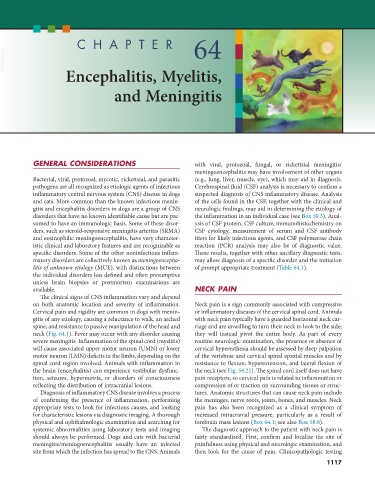Page 1145 - Small Animal Internal Medicine, 6th Edition
P. 1145
CHAPTER 64
VetBooks.ir
Encephalitis, Myelitis,
and Meningitis
GENERAL CONSIDERATIONS with viral, protozoal, fungal, or rickettsial meningitis/
meningoencephalitis may have involvement of other organs
Bacterial, viral, protozoal, mycotic, rickettsial, and parasitic (e.g., lung, liver, muscle, eye), which may aid in diagnosis.
pathogens are all recognized as etiologic agents of infectious Cerebrospinal fluid (CSF) analysis is necessary to confirm a
inflammatory central nervous system (CNS) disease in dogs suspected diagnosis of CNS inflammatory disease. Analysis
and cats. More common than the known infectious menin- of the cells found in the CSF, together with the clinical and
gitis and encephalitis disorders in dogs are a group of CNS neurologic findings, may aid in determining the etiology of
disorders that have no known identifiable cause but are pre- the inflammation in an individual case (see Box 59.3). Anal-
sumed to have an immunologic basis. Some of these disor- ysis of CSF protein, CSF culture, immunohistochemistry on
ders, such as steroid-responsive meningitis arteritis (SRMA) CSF cytology, measurement of serum and CSF antibody
and eosinophilic meningoencephalitis, have very character- titers for likely infectious agents, and CSF polymerase chain
istic clinical and laboratory features and are recognizable as reaction (PCR) analysis may also be of diagnostic value.
specific disorders. Some of the other noninfectious inflam- These results, together with other ancillary diagnostic tests,
matory disorders are collectively known as meningoencepha- may allow diagnosis of a specific disorder and the initiation
litis of unknown etiology (MUE), with distinctions between of prompt appropriate treatment (Table 64.1).
the individual disorders less defined and often presumptive
unless brain biopsies or postmortem examinations are
available. NECK PAIN
The clinical signs of CNS inflammation vary and depend
on both anatomic location and severity of inflammation. Neck pain is a sign commonly associated with compressive
Cervical pain and rigidity are common in dogs with menin- or inflammatory diseases of the cervical spinal cord. Animals
gitis of any etiology, causing a reluctance to walk, an arched with neck pain typically have a guarded horizontal neck car-
spine, and resistance to passive manipulation of the head and riage and are unwilling to turn their neck to look to the side;
neck (Fig. 64.1). Fever may occur with any disorder causing they will instead pivot the entire body. As part of every
severe meningitis. Inflammation of the spinal cord (myelitis) routine neurologic examination, the presence or absence of
will cause associated upper motor neuron (UMN) or lower cervical hyperesthesia should be assessed by deep palpation
motor neuron (LMN) deficits in the limbs, depending on the of the vertebrae and cervical spinal epaxial muscles and by
spinal cord region involved. Animals with inflammation in resistance to flexion, hyperextension, and lateral flexion of
the brain (encephalitis) can experience vestibular dysfunc- the neck (see Fig. 58.21). The spinal cord itself does not have
tion, seizures, hypermetria, or disorders of consciousness pain receptors, so cervical pain is related to inflammation or
reflecting the distribution of intracranial lesions. compression of or traction on surrounding tissues or struc-
Diagnosis of inflammatory CNS disease involves a process tures. Anatomic structures that can cause neck pain include
of confirming the presence of inflammation, performing the meninges, nerve roots, joints, bones, and muscles. Neck
appropriate tests to look for infectious causes, and looking pain has also been recognized as a clinical symptom of
for characteristic lesions via diagnostic imaging. A thorough increased intracranial pressure, particularly as a result of
physical and ophthalmologic examination and searching for forebrain mass lesions (Box 64.1; see also Box 58.8).
systemic abnormalities using laboratory tests and imaging The diagnostic approach to the patient with neck pain is
should always be performed. Dogs and cats with bacterial fairly standardized. First, confirm and localize the site of
meningitis/meningoencephalitis usually have an infected painfulness using physical and neurologic examination, and
site from which the infection has spread to the CNS. Animals then look for the cause of pain. Clinicopathologic testing
1117

